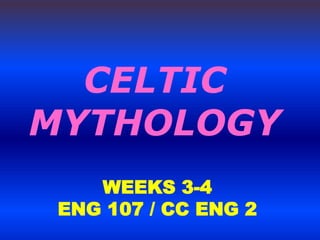
Celtic mythology
- 1. CELTIC MYTHOLOGY WEEKS 3-4 ENG 107 / CC ENG 2
- 2. CELTIC MYTHOLOGY •More localized unlike Greek, Roman and Egyptian myths •With 400 Celtic gods and goddesses (many are recognized by small cults)
- 3. DIVISIONS OF CELTIC MYTHOLOGY: 1.Gaulish mythology 2.Irish Mythology 3.Scottish Mythology
- 4. GAUL A vast area of Europe where France, Belgium, Switzerland and some surrounding areas are now located
- 5. Gaulish Mythology • Begins as an early Celtic Mythology • Eventually merges with Roman polytheism • One of the areas of French Mythology • Gauls did not write about their own religion, so much of what is known about their mythology is found in Latin works from Roman authors.
- 6. Irish Mythology • Was a part of the religion of the Irish before Christianity took hold • Was later preserved to some extent in storytelling
- 8. Mythological Origins of the Irish Race
- 9. Divisions of Irish Mythology 1.Mythological Cycle 2.Ulster Cycle 3.Fenian Cycle 4.Historical Cycles
- 10. 1. Mythological Cycle • Least intact • Describes the state of Irish mythology • Consists of numerous prose tales and poems found in medieval manuscripts: 1. Lebor Gabala Erenn 2. Annals of the Four Masters 3. Seathrun Ceitinn’s History of Ireland
- 11. 2. Ulster Cycle • Takes place as Christianity is taking hold in Ireland • Describes heroes rather than gods and goddesses • Deals with the lives of Conchobar mac Nessa, king of Ulster, the great hero Cuchulainn, and of their friends, lovers and enemies • Stories are written mainly in prose • Centerpiece is TAIN BO CUAILNGE (Cattle Raid of Cooley)
- 12. 3. Fenian Cycle • A body of prose and verse centering on the exploits of the mythical hero Fionn mac Cumhaill and his warriors, the Fianna • Also known as the Fianna Cycle, Fionn Cycle, Finn Cycle and Ossianic Cycle
- 13. 4. Historical Cycles • Also known as the Cycles of Kings • A body of Old and Middle Irish literature • Contain stories of the legendary kings of Ireland
- 14. Court Poets or Medieval Irish Bards • Record the history of the family and the genealogy of the king they served • Did in poems that blended the mythological and the historical to a greater or lesser degree • Resulted to the Historical Cycles
- 15. Greatest Glory of the Cycle: Buile Shuibhne (The Frenzy of Sweeney) 12th century
- 16. IRISH GODDESSES
- 17. Scottish Mythology • Myths have emerged for various purposes throughout the history of Scotland.
- 18. Map of Scotland
- 19. Scottish Origins • Several were created during the Historical Period • One was adapted from the 10th century Latin life of St. Cathroe of Metz
- 20. Hebridian Myths and Legends 1. Water spirits • Kelpies • Blue Men of the Minch • Seonaidh • Merpeople • Water Monsters 2. Wulvers 3. Will-o-the-Wisp 4. Fairies 5. Changeling
- 21. Kelpies • Occupy several lochs • In the form of a horse • Takes people for food
- 22. Blue Men of the Minch • Also known as storm kelpies • Occupy the stretch of water between Lewis and Mainland Scotland • Looks for sailors to drown and stricken boats to sink
- 23. Seonaidh •A water spirit who had to be offered ale
- 24. Merpeople • Creature of half man and half fish • Claimed that a mermaid’s grave is in Benbecula • Accounts stated that the upper part of the creature was the size of an infant, while the bottom was like a salmon.
- 25. Loch Monsters • Resembles a capsized boat • Has been reported swimming for one and a half centuries • Locals say lambs were once offered annually to the creature.
- 26. Will-o-the-wisp • Have been reported in the areas of Sandwick • Lights that float around the area normally announce approaching death of a local • Some say that light belongs to an Irish merchant who was robbed and murdered on the island.
- 27. Fairies • Beautiful winged creatures • Known to have magical powers
- 28. Wulvers • Descendants of werewolves • Promised to rise if their graves were disturbed
- 29. Changeling • Typically described as being the offspring of a fairy, troll elf or other legendary creature that has been secretly left in the place of a human child • Sometimes the term is also used to refer to the child who was taken.
- 30. Fir Bolg • First established kingship and a system of justice in Ireland • Represent a genuine historical people
- 31. Tuatha De Danaan • “Peoples of the Goddess Danu” • Defeated the Fir Bolg King, Eochaid mac Eirc, in the First Battle of Magh Tuiredh
- 32. Dindshenchas • Another source of mythological tradition • “Lore of places” • Poems and prose tales recounting traditions of the origins of place- names and events and personages associated with those places
- 33. Conaire Mor • “The Great Son” • Son of Eterscel, the High King of Ireland • Reign is long and peaceful • Belonged to the legendary Clanna Dedad, the legendary royal family of the Erainn • Last king in the direct male line from Conaire Mor was Alexander III of Scotland.
